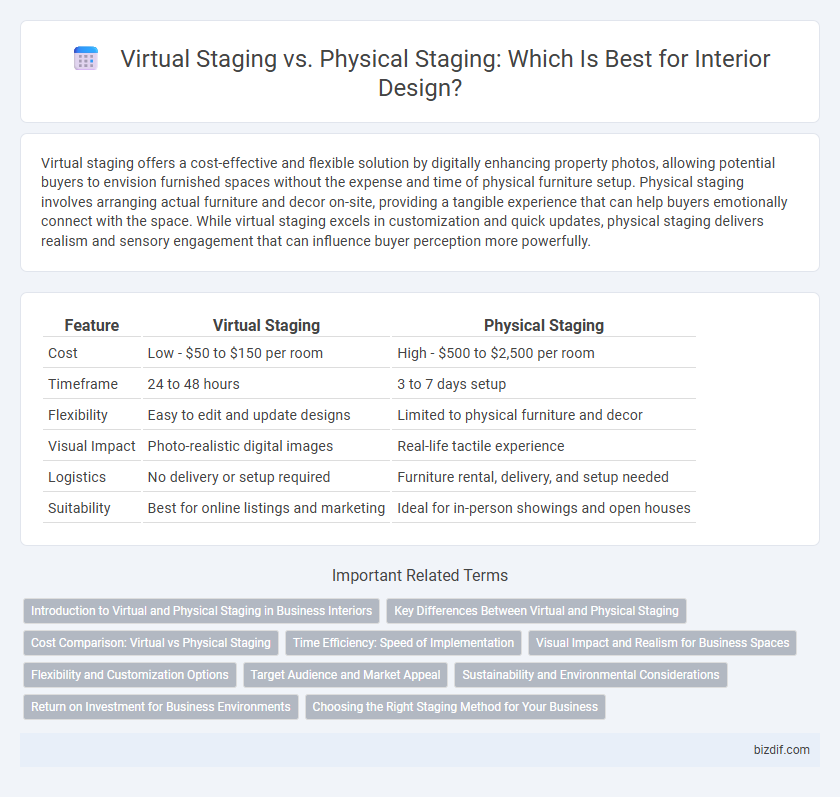Virtual staging offers a cost-effective and flexible solution by digitally enhancing property photos, allowing potential buyers to envision furnished spaces without the expense and time of physical furniture setup. Physical staging involves arranging actual furniture and decor on-site, providing a tangible experience that can help buyers emotionally connect with the space. While virtual staging excels in customization and quick updates, physical staging delivers realism and sensory engagement that can influence buyer perception more powerfully.
Table of Comparison
| Feature | Virtual Staging | Physical Staging |
|---|---|---|
| Cost | Low - $50 to $150 per room | High - $500 to $2,500 per room |
| Timeframe | 24 to 48 hours | 3 to 7 days setup |
| Flexibility | Easy to edit and update designs | Limited to physical furniture and decor |
| Visual Impact | Photo-realistic digital images | Real-life tactile experience |
| Logistics | No delivery or setup required | Furniture rental, delivery, and setup needed |
| Suitability | Best for online listings and marketing | Ideal for in-person showings and open houses |
Introduction to Virtual and Physical Staging in Business Interiors
Virtual staging transforms business interiors by digitally furnishing and decorating empty office spaces, offering cost-effective and flexible solutions for showcasing potential layouts and design concepts. Physical staging involves the placement of real furniture and decor to create a tangible and immersive environment, enhancing client experience and allowing stakeholders to physically engage with the space. Both methods aim to highlight interior functionality and aesthetic appeal, driving leasing and sales in commercial real estate markets.
Key Differences Between Virtual and Physical Staging
Virtual staging uses digital technology to create realistic furniture and decor within photos of empty spaces, offering cost-effective and flexible design options. Physical staging involves placing actual furniture and accessories in a property, providing a tangible experience that helps buyers better perceive space and scale. While virtual staging allows for rapid changes without logistical constraints, physical staging delivers authentic ambiance but requires higher investment and more time for setup.
Cost Comparison: Virtual vs Physical Staging
Virtual staging typically costs between $50 and $150 per image, making it a highly cost-effective option compared to physical staging, which can range from $2,000 to $5,000 per property due to furniture rental, delivery, and labor expenses. Physical staging involves ongoing costs such as maintenance, transportation, and insurance that further increase the total investment, whereas virtual staging requires no physical materials or onsite personnel. Real estate agents and sellers often prefer virtual staging for budget-conscious marketing strategies that still deliver visually appealing property presentations.
Time Efficiency: Speed of Implementation
Virtual staging offers unmatched speed, enabling interior designers to transform spaces digitally within hours, significantly reducing project timelines. Physical staging requires scheduling, arranging, and dismantling furniture and decor, often extending the process to several days. This rapid implementation of virtual staging supports faster decision-making and accelerated property marketing.
Visual Impact and Realism for Business Spaces
Virtual staging offers businesses a cost-effective solution with high visual impact through customizable, photorealistic designs that enhance online listings and presentations. Physical staging provides authentic realism by allowing clients to experience the tangible texture, scale, and spatial relationships of furniture and decor in the actual business environment. Choosing between virtual and physical staging depends on budget constraints, project timeline, and the need for immersive, sensory engagement in commercial real estate marketing.
Flexibility and Customization Options
Virtual staging offers unparalleled flexibility and customization by enabling rapid changes to furniture, color schemes, and decor styles without the need for physical labor, making it ideal for diverse design preferences and last-minute adjustments. Physical staging provides tactile realism and direct interaction with actual materials and furnishings, but modifications often require significant time, effort, and cost. Virtual staging leverages advanced software to tailor interior layouts, enhancing marketing appeal with limitless design variations while physical staging remains constrained by inventory availability and logistical challenges.
Target Audience and Market Appeal
Virtual staging appeals primarily to real estate agents and sellers targeting tech-savvy buyers and investors seeking cost-effective, flexible, and quickly updated property presentations. Physical staging attracts homeowners and luxury market clients who prioritize tactile experiences and emotional connections to furnished spaces that highlight scale and texture. Both methods serve distinct market segments, with virtual staging excelling in scalability and marketing efficiency while physical staging enhances high-end appeal and in-person engagement.
Sustainability and Environmental Considerations
Virtual staging significantly reduces environmental impact by eliminating the need for furniture transportation, manufacturing, and waste associated with physical staging. Physical staging often involves carbon emissions from delivery trucks and the production of temporary decor, contributing to landfill waste when items are discarded. Prioritizing virtual staging supports sustainable interior design practices by minimizing resource consumption and promoting eco-friendly real estate marketing.
Return on Investment for Business Environments
Virtual staging offers a higher return on investment for business environments by reducing costs associated with furniture rental, labor, and transportation while delivering a flexible and easily customizable visual presentation. Physical staging can create a tangible, immersive experience that may enhance emotional engagement and perceived value, but it involves significant upfront expenses and logistical challenges. Businesses leveraging virtual staging benefit from faster turnaround times and scalable solutions that optimize marketing budgets and attract a broader range of potential clients.
Choosing the Right Staging Method for Your Business
Virtual staging offers a cost-effective and flexible solution for real estate professionals aiming to showcase properties with customizable digital furniture and decor, reducing the need for physical logistics. Physical staging provides a tangible, immersive experience that helps potential buyers visualize space effectively through actual furniture placement, enhancing emotional connection. Choosing the right staging method depends on budget constraints, marketing goals, target audience preferences, and property type, ensuring alignment with business objectives for maximum impact.
Virtual Staging vs Physical Staging Infographic

 bizdif.com
bizdif.com